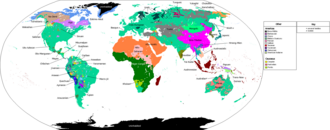
Back قائمة اللغات حسب العدد الكلي للمتحدثين Arabic भासी लोगन के संख्या के अनुसार भासा सभ के सूची Bihari মোট ব্যবহারকারীর সংখ্যা অনুসারে ভাষাসমূহের তালিকা Bengali/Bangla Liste der meistgesprochenen Sprachen German Anexo:Idiomas por el total de hablantes Spanish فهرست زبانها بر پایه مجموع تعداد سخنوران Persian Luettelo kielistä puhujamäärän perusteella Finnish Liste de langues par nombre total de locuteurs French भाषाभाषियों की कुल संख्या के अनुसार भाषाओं की सूची Hindi Լեզուների ցանկ ըստ լեզվով խոսողների ընդհանուր թվի Armenian

This is a list of languages by total number of speakers.
It is difficult to define what constitutes a language as opposed to a dialect. For example, Chinese and Arabic are sometimes considered single languages, but each includes several mutually unintelligible varieties, and so they are sometimes considered language families instead. Conversely, colloquial registers of Hindi and Urdu are almost completely mutually intelligible, and are sometimes classified as one language, Hindustani. Such rankings should be used with caution, because it is not possible to devise a coherent set of linguistic criteria for distinguishing languages in a dialect continuum.[1]
There is no single criterion for how much knowledge is sufficient to be counted as a second-language speaker. For example, English has about 450 million native speakers but, depending on the criterion chosen, can be said to have as many as two billion speakers.[2]
There are also difficulties in obtaining reliable counts of speakers, which vary over time because of population change and language shift. In some areas, there is no reliable census data, the data is not current, or the census may not record languages spoken, or record them ambiguously. Sometimes speaker populations are exaggerated for political reasons, or speakers of minority languages may be underreported in favor of a national language.[3]
- ^ Paolillo, John C.; Das, Anupam (31 March 2006). "Evaluating language statistics: the Ethnologue and beyond" (PDF). UNESCO Institute of Statistics. pp. 3–5. Retrieved 17 November 2018.
- ^ Crystal, David (March 2008). "Two thousand million?". English Today. 24: 3–6. doi:10.1017/S0266078408000023. S2CID 145597019.
- ^ Crystal, David (1988). The Cambridge Encyclopedia of Language. Cambridge University Press. pp. 286–287. ISBN 978-0-521-26438-9.